Analysis of Business Environment and Sectors: Tesco Report
VerifiedAdded on 2020/01/23
|25
|7684
|77
Report
AI Summary
This report provides a comprehensive analysis of the business environment, focusing on Tesco as a case study. It begins by defining the business environment and its impact on organizational performance. The report then delves into different sector organizations in the UK, including public, private, and voluntary sectors, outlining their objectives and legal requirements. The analysis further explores the size and scope of these organizations, comparing their visions and operational strategies. A significant portion of the report examines the relationship between organizational functions and their alignment with objectives and structure. The positive and negative impacts of the macro environment on business performance are also assessed. The report includes internal and external analyses of Tesco, evaluating its strengths, weaknesses, and the interplay with external factors. The conclusion summarizes the key findings, emphasizing the importance of understanding the business environment for organizational success. The report references several academic sources to support its analysis, providing a well-researched overview of the subject matter.
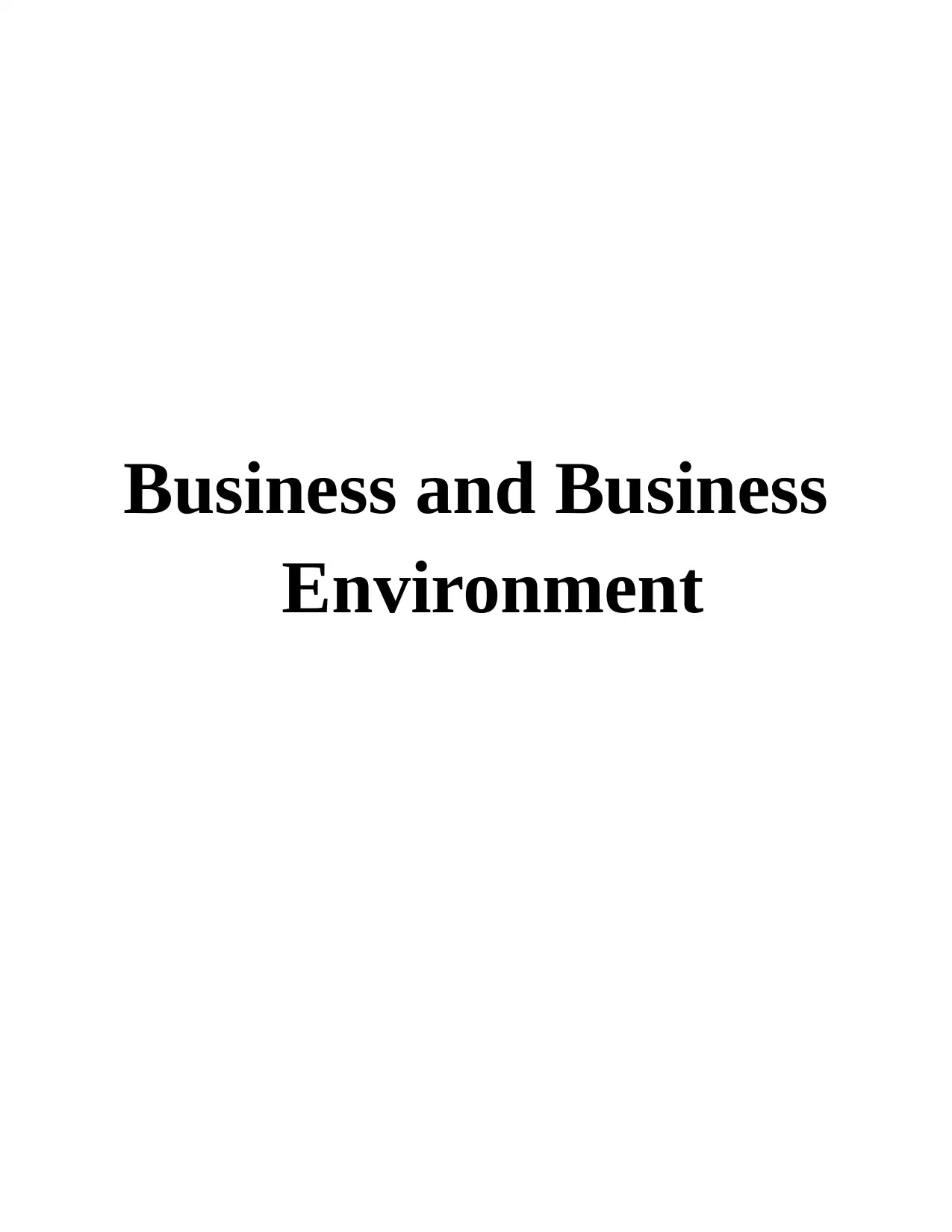
Business and Business
Environment
Environment
Paraphrase This Document
Need a fresh take? Get an instant paraphrase of this document with our AI Paraphraser
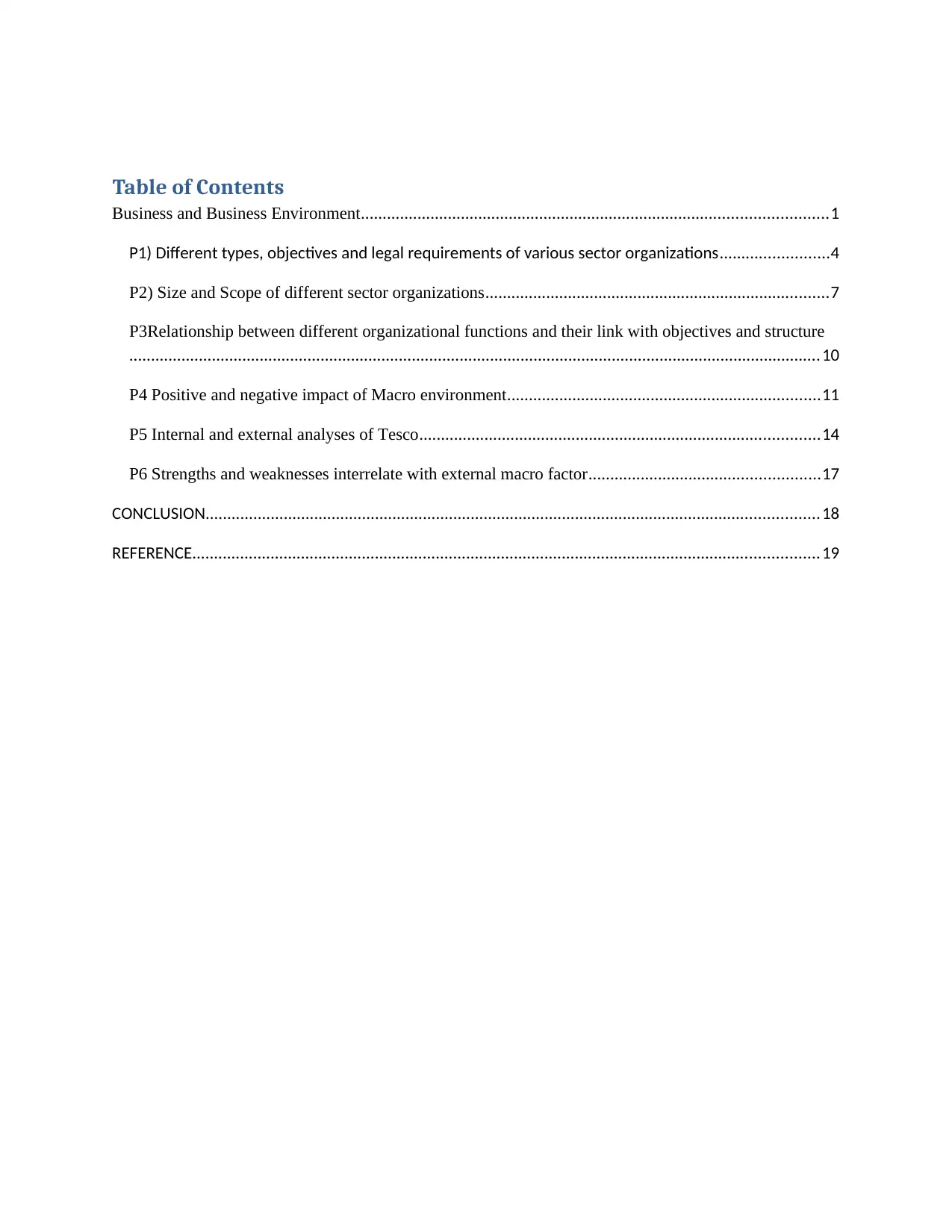
Table of Contents
Business and Business Environment...........................................................................................................1
P1) Different types, objectives and legal requirements of various sector organizations.........................4
P2) Size and Scope of different sector organizations...............................................................................7
P3Relationship between different organizational functions and their link with objectives and structure
...............................................................................................................................................................10
P4 Positive and negative impact of Macro environment........................................................................11
P5 Internal and external analyses of Tesco............................................................................................14
P6 Strengths and weaknesses interrelate with external macro factor.....................................................17
CONCLUSION.............................................................................................................................................18
REFERENCE................................................................................................................................................19
Business and Business Environment...........................................................................................................1
P1) Different types, objectives and legal requirements of various sector organizations.........................4
P2) Size and Scope of different sector organizations...............................................................................7
P3Relationship between different organizational functions and their link with objectives and structure
...............................................................................................................................................................10
P4 Positive and negative impact of Macro environment........................................................................11
P5 Internal and external analyses of Tesco............................................................................................14
P6 Strengths and weaknesses interrelate with external macro factor.....................................................17
CONCLUSION.............................................................................................................................................18
REFERENCE................................................................................................................................................19
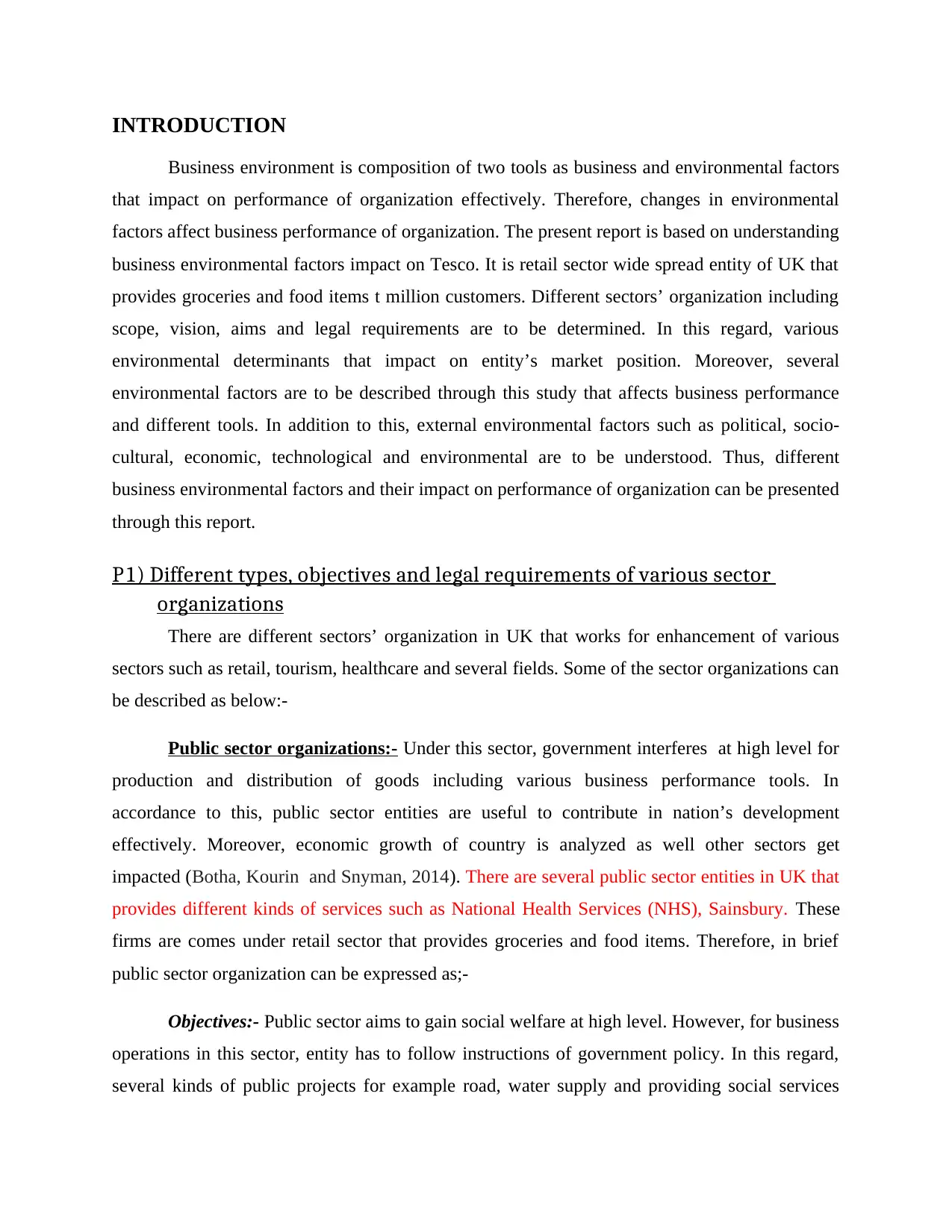
INTRODUCTION
Business environment is composition of two tools as business and environmental factors
that impact on performance of organization effectively. Therefore, changes in environmental
factors affect business performance of organization. The present report is based on understanding
business environmental factors impact on Tesco. It is retail sector wide spread entity of UK that
provides groceries and food items t million customers. Different sectors’ organization including
scope, vision, aims and legal requirements are to be determined. In this regard, various
environmental determinants that impact on entity’s market position. Moreover, several
environmental factors are to be described through this study that affects business performance
and different tools. In addition to this, external environmental factors such as political, socio-
cultural, economic, technological and environmental are to be understood. Thus, different
business environmental factors and their impact on performance of organization can be presented
through this report.
P1) Different types, objectives and legal requirements of various sector
organizations
There are different sectors’ organization in UK that works for enhancement of various
sectors such as retail, tourism, healthcare and several fields. Some of the sector organizations can
be described as below:-
Public sector organizations:- Under this sector, government interferes at high level for
production and distribution of goods including various business performance tools. In
accordance to this, public sector entities are useful to contribute in nation’s development
effectively. Moreover, economic growth of country is analyzed as well other sectors get
impacted (Botha, Kourin and Snyman, 2014). There are several public sector entities in UK that
provides different kinds of services such as National Health Services (NHS), Sainsbury. These
firms are comes under retail sector that provides groceries and food items. Therefore, in brief
public sector organization can be expressed as;-
Objectives:- Public sector aims to gain social welfare at high level. However, for business
operations in this sector, entity has to follow instructions of government policy. In this regard,
several kinds of public projects for example road, water supply and providing social services
Business environment is composition of two tools as business and environmental factors
that impact on performance of organization effectively. Therefore, changes in environmental
factors affect business performance of organization. The present report is based on understanding
business environmental factors impact on Tesco. It is retail sector wide spread entity of UK that
provides groceries and food items t million customers. Different sectors’ organization including
scope, vision, aims and legal requirements are to be determined. In this regard, various
environmental determinants that impact on entity’s market position. Moreover, several
environmental factors are to be described through this study that affects business performance
and different tools. In addition to this, external environmental factors such as political, socio-
cultural, economic, technological and environmental are to be understood. Thus, different
business environmental factors and their impact on performance of organization can be presented
through this report.
P1) Different types, objectives and legal requirements of various sector
organizations
There are different sectors’ organization in UK that works for enhancement of various
sectors such as retail, tourism, healthcare and several fields. Some of the sector organizations can
be described as below:-
Public sector organizations:- Under this sector, government interferes at high level for
production and distribution of goods including various business performance tools. In
accordance to this, public sector entities are useful to contribute in nation’s development
effectively. Moreover, economic growth of country is analyzed as well other sectors get
impacted (Botha, Kourin and Snyman, 2014). There are several public sector entities in UK that
provides different kinds of services such as National Health Services (NHS), Sainsbury. These
firms are comes under retail sector that provides groceries and food items. Therefore, in brief
public sector organization can be expressed as;-
Objectives:- Public sector aims to gain social welfare at high level. However, for business
operations in this sector, entity has to follow instructions of government policy. In this regard,
several kinds of public projects for example road, water supply and providing social services
⊘ This is a preview!⊘
Do you want full access?
Subscribe today to unlock all pages.

Trusted by 1+ million students worldwide
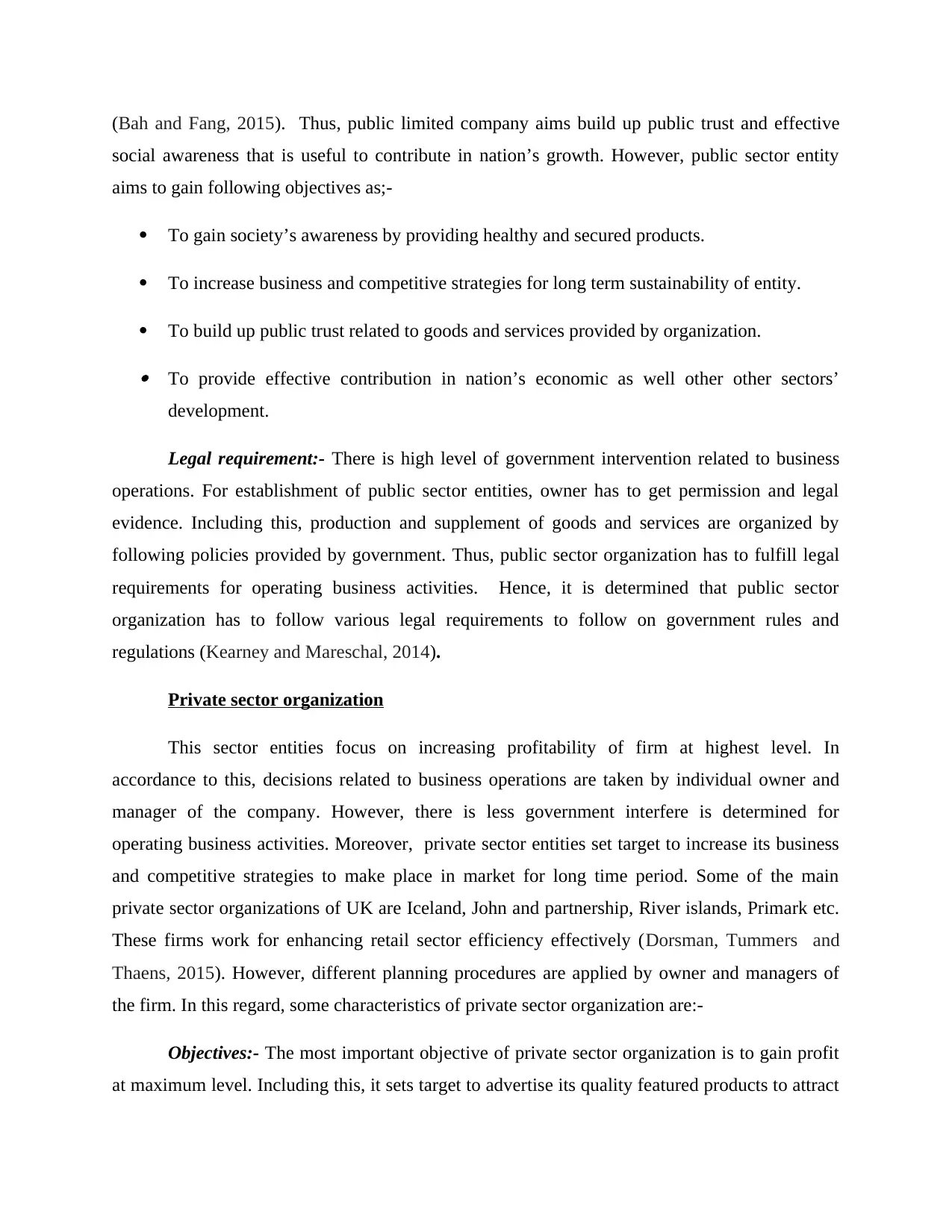
(Bah and Fang, 2015). Thus, public limited company aims build up public trust and effective
social awareness that is useful to contribute in nation’s growth. However, public sector entity
aims to gain following objectives as;-
To gain society’s awareness by providing healthy and secured products.
To increase business and competitive strategies for long term sustainability of entity.
To build up public trust related to goods and services provided by organization.
To provide effective contribution in nation’s economic as well other other sectors’
development.
Legal requirement:- There is high level of government intervention related to business
operations. For establishment of public sector entities, owner has to get permission and legal
evidence. Including this, production and supplement of goods and services are organized by
following policies provided by government. Thus, public sector organization has to fulfill legal
requirements for operating business activities. Hence, it is determined that public sector
organization has to follow various legal requirements to follow on government rules and
regulations (Kearney and Mareschal, 2014).
Private sector organization
This sector entities focus on increasing profitability of firm at highest level. In
accordance to this, decisions related to business operations are taken by individual owner and
manager of the company. However, there is less government interfere is determined for
operating business activities. Moreover, private sector entities set target to increase its business
and competitive strategies to make place in market for long time period. Some of the main
private sector organizations of UK are Iceland, John and partnership, River islands, Primark etc.
These firms work for enhancing retail sector efficiency effectively (Dorsman, Tummers and
Thaens, 2015). However, different planning procedures are applied by owner and managers of
the firm. In this regard, some characteristics of private sector organization are:-
Objectives:- The most important objective of private sector organization is to gain profit
at maximum level. Including this, it sets target to advertise its quality featured products to attract
social awareness that is useful to contribute in nation’s growth. However, public sector entity
aims to gain following objectives as;-
To gain society’s awareness by providing healthy and secured products.
To increase business and competitive strategies for long term sustainability of entity.
To build up public trust related to goods and services provided by organization.
To provide effective contribution in nation’s economic as well other other sectors’
development.
Legal requirement:- There is high level of government intervention related to business
operations. For establishment of public sector entities, owner has to get permission and legal
evidence. Including this, production and supplement of goods and services are organized by
following policies provided by government. Thus, public sector organization has to fulfill legal
requirements for operating business activities. Hence, it is determined that public sector
organization has to follow various legal requirements to follow on government rules and
regulations (Kearney and Mareschal, 2014).
Private sector organization
This sector entities focus on increasing profitability of firm at highest level. In
accordance to this, decisions related to business operations are taken by individual owner and
manager of the company. However, there is less government interfere is determined for
operating business activities. Moreover, private sector entities set target to increase its business
and competitive strategies to make place in market for long time period. Some of the main
private sector organizations of UK are Iceland, John and partnership, River islands, Primark etc.
These firms work for enhancing retail sector efficiency effectively (Dorsman, Tummers and
Thaens, 2015). However, different planning procedures are applied by owner and managers of
the firm. In this regard, some characteristics of private sector organization are:-
Objectives:- The most important objective of private sector organization is to gain profit
at maximum level. Including this, it sets target to advertise its quality featured products to attract
Paraphrase This Document
Need a fresh take? Get an instant paraphrase of this document with our AI Paraphraser
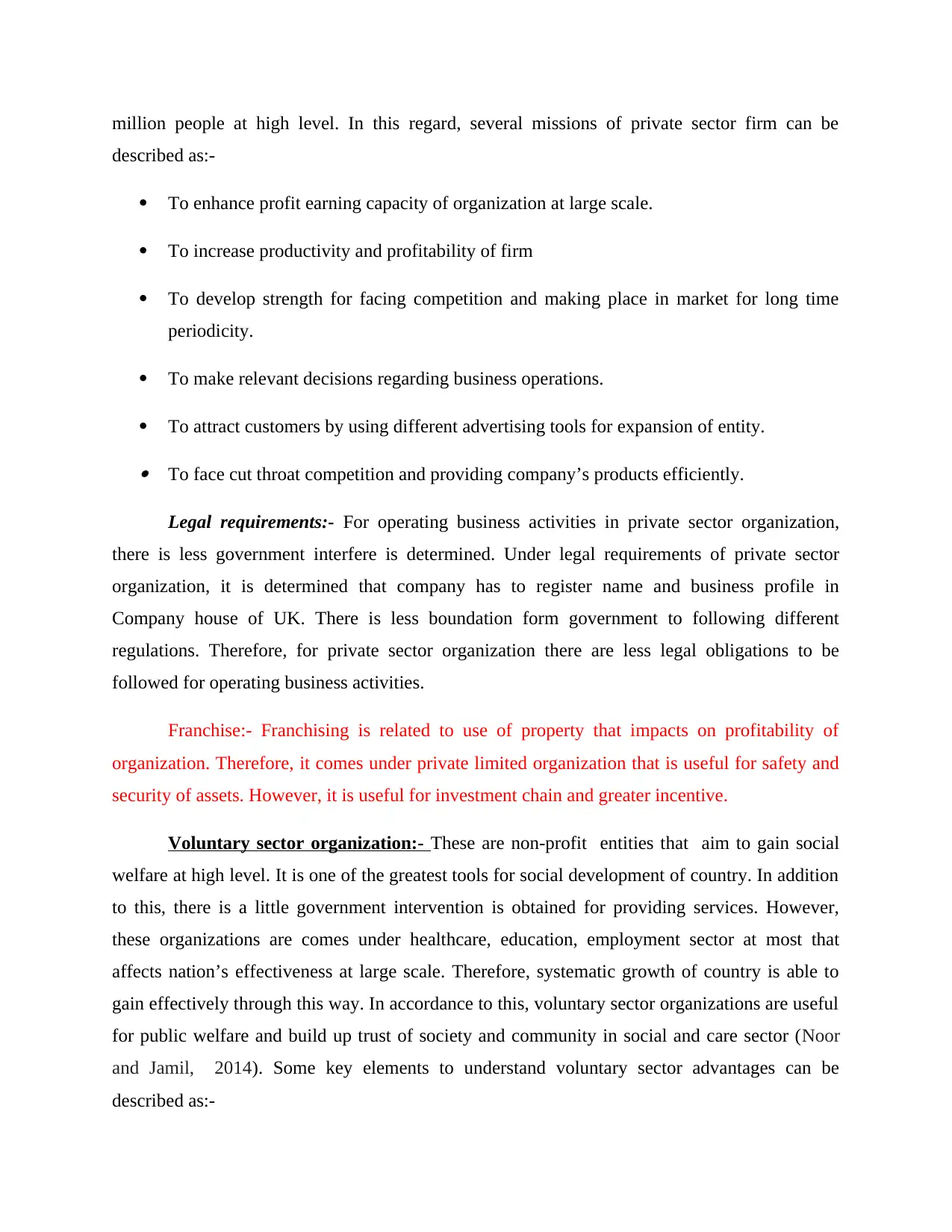
million people at high level. In this regard, several missions of private sector firm can be
described as:-
To enhance profit earning capacity of organization at large scale.
To increase productivity and profitability of firm
To develop strength for facing competition and making place in market for long time
periodicity.
To make relevant decisions regarding business operations.
To attract customers by using different advertising tools for expansion of entity.
To face cut throat competition and providing company’s products efficiently.
Legal requirements:- For operating business activities in private sector organization,
there is less government interfere is determined. Under legal requirements of private sector
organization, it is determined that company has to register name and business profile in
Company house of UK. There is less boundation form government to following different
regulations. Therefore, for private sector organization there are less legal obligations to be
followed for operating business activities.
Franchise:- Franchising is related to use of property that impacts on profitability of
organization. Therefore, it comes under private limited organization that is useful for safety and
security of assets. However, it is useful for investment chain and greater incentive.
Voluntary sector organization:- These are non-profit entities that aim to gain social
welfare at high level. It is one of the greatest tools for social development of country. In addition
to this, there is a little government intervention is obtained for providing services. However,
these organizations are comes under healthcare, education, employment sector at most that
affects nation’s effectiveness at large scale. Therefore, systematic growth of country is able to
gain effectively through this way. In accordance to this, voluntary sector organizations are useful
for public welfare and build up trust of society and community in social and care sector (Noor
and Jamil, 2014). Some key elements to understand voluntary sector advantages can be
described as:-
described as:-
To enhance profit earning capacity of organization at large scale.
To increase productivity and profitability of firm
To develop strength for facing competition and making place in market for long time
periodicity.
To make relevant decisions regarding business operations.
To attract customers by using different advertising tools for expansion of entity.
To face cut throat competition and providing company’s products efficiently.
Legal requirements:- For operating business activities in private sector organization,
there is less government interfere is determined. Under legal requirements of private sector
organization, it is determined that company has to register name and business profile in
Company house of UK. There is less boundation form government to following different
regulations. Therefore, for private sector organization there are less legal obligations to be
followed for operating business activities.
Franchise:- Franchising is related to use of property that impacts on profitability of
organization. Therefore, it comes under private limited organization that is useful for safety and
security of assets. However, it is useful for investment chain and greater incentive.
Voluntary sector organization:- These are non-profit entities that aim to gain social
welfare at high level. It is one of the greatest tools for social development of country. In addition
to this, there is a little government intervention is obtained for providing services. However,
these organizations are comes under healthcare, education, employment sector at most that
affects nation’s effectiveness at large scale. Therefore, systematic growth of country is able to
gain effectively through this way. In accordance to this, voluntary sector organizations are useful
for public welfare and build up trust of society and community in social and care sector (Noor
and Jamil, 2014). Some key elements to understand voluntary sector advantages can be
described as:-
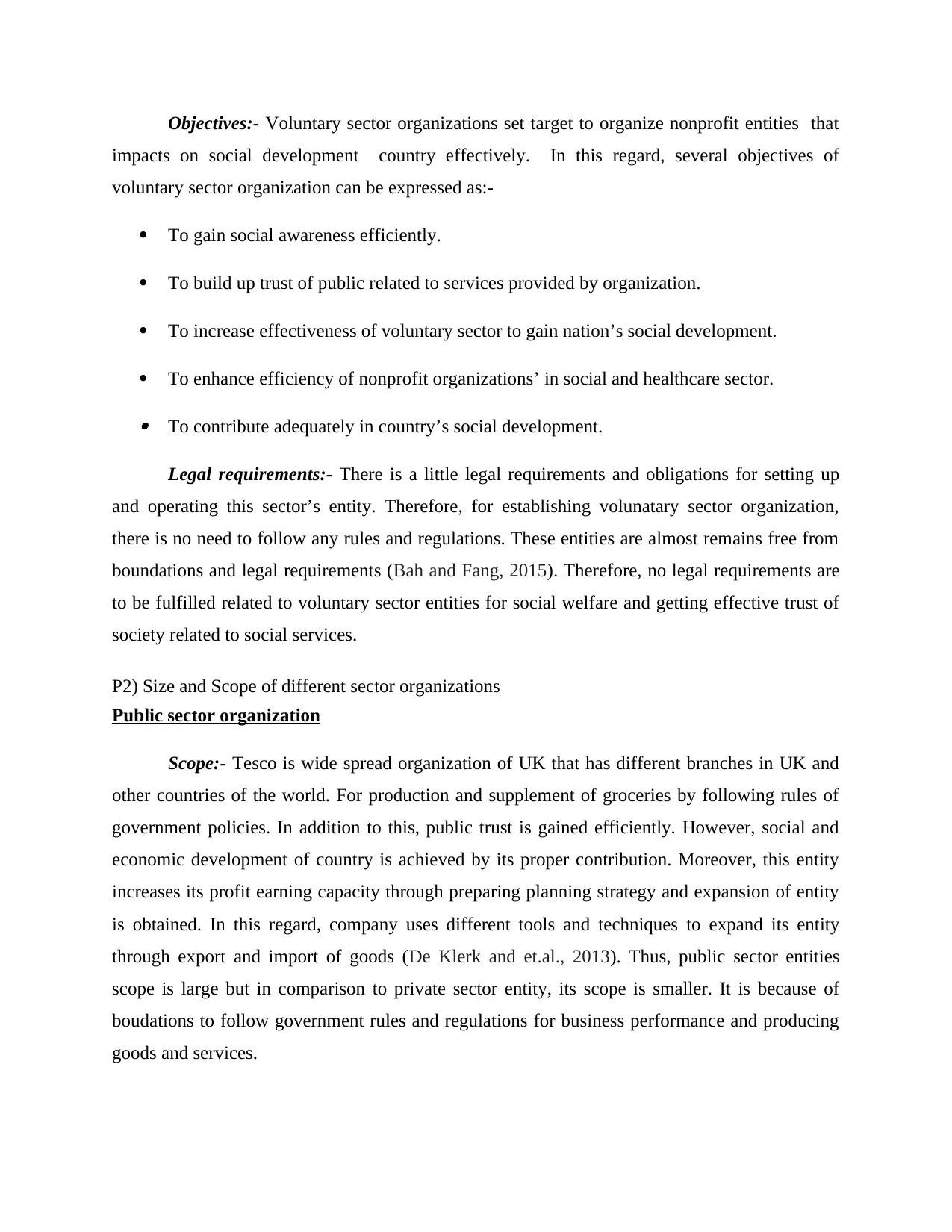
Objectives:- Voluntary sector organizations set target to organize nonprofit entities that
impacts on social development country effectively. In this regard, several objectives of
voluntary sector organization can be expressed as:-
To gain social awareness efficiently.
To build up trust of public related to services provided by organization.
To increase effectiveness of voluntary sector to gain nation’s social development.
To enhance efficiency of nonprofit organizations’ in social and healthcare sector.
To contribute adequately in country’s social development.
Legal requirements:- There is a little legal requirements and obligations for setting up
and operating this sector’s entity. Therefore, for establishing volunatary sector organization,
there is no need to follow any rules and regulations. These entities are almost remains free from
boundations and legal requirements (Bah and Fang, 2015). Therefore, no legal requirements are
to be fulfilled related to voluntary sector entities for social welfare and getting effective trust of
society related to social services.
P2) Size and Scope of different sector organizations
Public sector organization
Scope:- Tesco is wide spread organization of UK that has different branches in UK and
other countries of the world. For production and supplement of groceries by following rules of
government policies. In addition to this, public trust is gained efficiently. However, social and
economic development of country is achieved by its proper contribution. Moreover, this entity
increases its profit earning capacity through preparing planning strategy and expansion of entity
is obtained. In this regard, company uses different tools and techniques to expand its entity
through export and import of goods (De Klerk and et.al., 2013). Thus, public sector entities
scope is large but in comparison to private sector entity, its scope is smaller. It is because of
boudations to follow government rules and regulations for business performance and producing
goods and services.
impacts on social development country effectively. In this regard, several objectives of
voluntary sector organization can be expressed as:-
To gain social awareness efficiently.
To build up trust of public related to services provided by organization.
To increase effectiveness of voluntary sector to gain nation’s social development.
To enhance efficiency of nonprofit organizations’ in social and healthcare sector.
To contribute adequately in country’s social development.
Legal requirements:- There is a little legal requirements and obligations for setting up
and operating this sector’s entity. Therefore, for establishing volunatary sector organization,
there is no need to follow any rules and regulations. These entities are almost remains free from
boundations and legal requirements (Bah and Fang, 2015). Therefore, no legal requirements are
to be fulfilled related to voluntary sector entities for social welfare and getting effective trust of
society related to social services.
P2) Size and Scope of different sector organizations
Public sector organization
Scope:- Tesco is wide spread organization of UK that has different branches in UK and
other countries of the world. For production and supplement of groceries by following rules of
government policies. In addition to this, public trust is gained efficiently. However, social and
economic development of country is achieved by its proper contribution. Moreover, this entity
increases its profit earning capacity through preparing planning strategy and expansion of entity
is obtained. In this regard, company uses different tools and techniques to expand its entity
through export and import of goods (De Klerk and et.al., 2013). Thus, public sector entities
scope is large but in comparison to private sector entity, its scope is smaller. It is because of
boudations to follow government rules and regulations for business performance and producing
goods and services.
⊘ This is a preview!⊘
Do you want full access?
Subscribe today to unlock all pages.

Trusted by 1+ million students worldwide
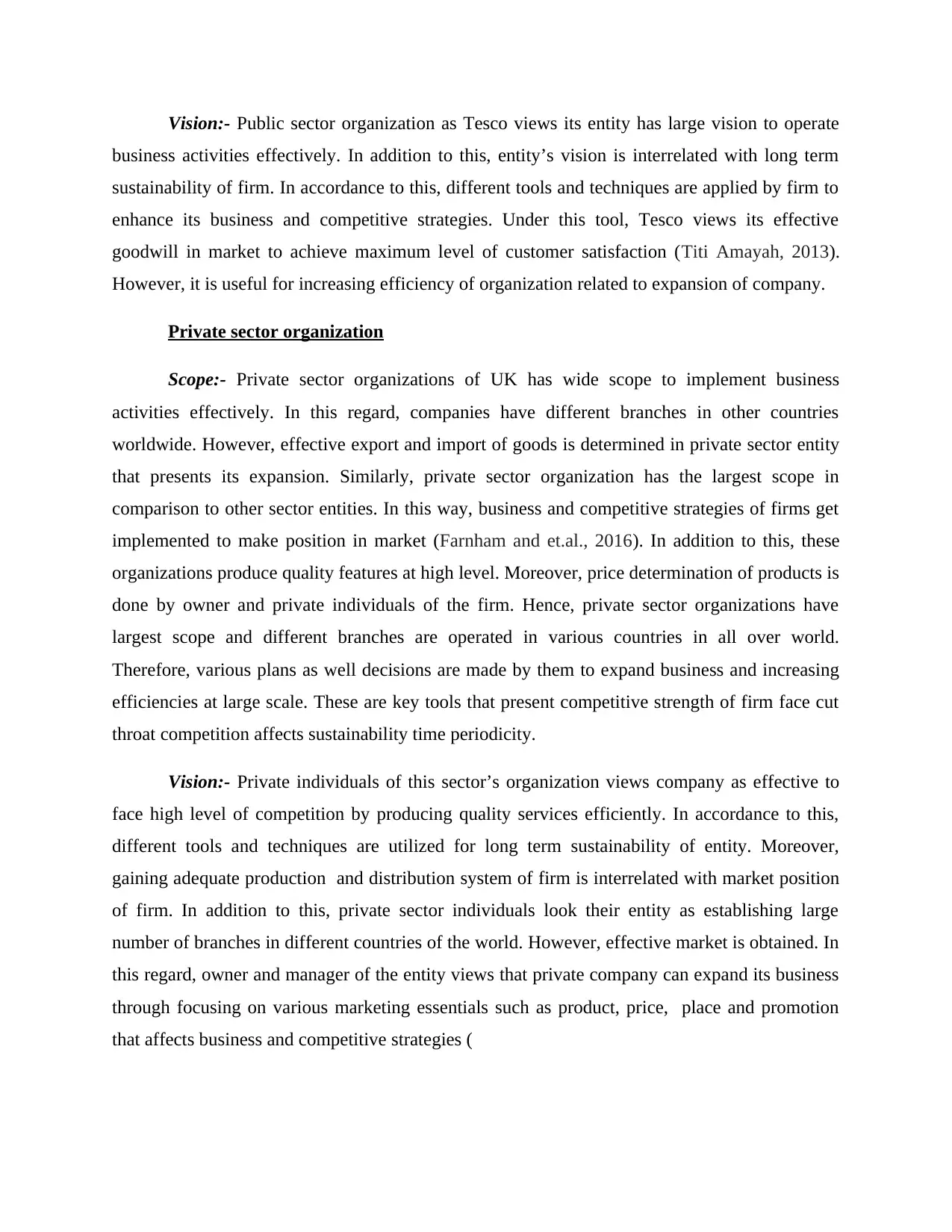
Vision:- Public sector organization as Tesco views its entity has large vision to operate
business activities effectively. In addition to this, entity’s vision is interrelated with long term
sustainability of firm. In accordance to this, different tools and techniques are applied by firm to
enhance its business and competitive strategies. Under this tool, Tesco views its effective
goodwill in market to achieve maximum level of customer satisfaction (Titi Amayah, 2013).
However, it is useful for increasing efficiency of organization related to expansion of company.
Private sector organization
Scope:- Private sector organizations of UK has wide scope to implement business
activities effectively. In this regard, companies have different branches in other countries
worldwide. However, effective export and import of goods is determined in private sector entity
that presents its expansion. Similarly, private sector organization has the largest scope in
comparison to other sector entities. In this way, business and competitive strategies of firms get
implemented to make position in market (Farnham and et.al., 2016). In addition to this, these
organizations produce quality features at high level. Moreover, price determination of products is
done by owner and private individuals of the firm. Hence, private sector organizations have
largest scope and different branches are operated in various countries in all over world.
Therefore, various plans as well decisions are made by them to expand business and increasing
efficiencies at large scale. These are key tools that present competitive strength of firm face cut
throat competition affects sustainability time periodicity.
Vision:- Private individuals of this sector’s organization views company as effective to
face high level of competition by producing quality services efficiently. In accordance to this,
different tools and techniques are utilized for long term sustainability of entity. Moreover,
gaining adequate production and distribution system of firm is interrelated with market position
of firm. In addition to this, private sector individuals look their entity as establishing large
number of branches in different countries of the world. However, effective market is obtained. In
this regard, owner and manager of the entity views that private company can expand its business
through focusing on various marketing essentials such as product, price, place and promotion
that affects business and competitive strategies (
business activities effectively. In addition to this, entity’s vision is interrelated with long term
sustainability of firm. In accordance to this, different tools and techniques are applied by firm to
enhance its business and competitive strategies. Under this tool, Tesco views its effective
goodwill in market to achieve maximum level of customer satisfaction (Titi Amayah, 2013).
However, it is useful for increasing efficiency of organization related to expansion of company.
Private sector organization
Scope:- Private sector organizations of UK has wide scope to implement business
activities effectively. In this regard, companies have different branches in other countries
worldwide. However, effective export and import of goods is determined in private sector entity
that presents its expansion. Similarly, private sector organization has the largest scope in
comparison to other sector entities. In this way, business and competitive strategies of firms get
implemented to make position in market (Farnham and et.al., 2016). In addition to this, these
organizations produce quality features at high level. Moreover, price determination of products is
done by owner and private individuals of the firm. Hence, private sector organizations have
largest scope and different branches are operated in various countries in all over world.
Therefore, various plans as well decisions are made by them to expand business and increasing
efficiencies at large scale. These are key tools that present competitive strength of firm face cut
throat competition affects sustainability time periodicity.
Vision:- Private individuals of this sector’s organization views company as effective to
face high level of competition by producing quality services efficiently. In accordance to this,
different tools and techniques are utilized for long term sustainability of entity. Moreover,
gaining adequate production and distribution system of firm is interrelated with market position
of firm. In addition to this, private sector individuals look their entity as establishing large
number of branches in different countries of the world. However, effective market is obtained. In
this regard, owner and manager of the entity views that private company can expand its business
through focusing on various marketing essentials such as product, price, place and promotion
that affects business and competitive strategies (
Paraphrase This Document
Need a fresh take? Get an instant paraphrase of this document with our AI Paraphraser
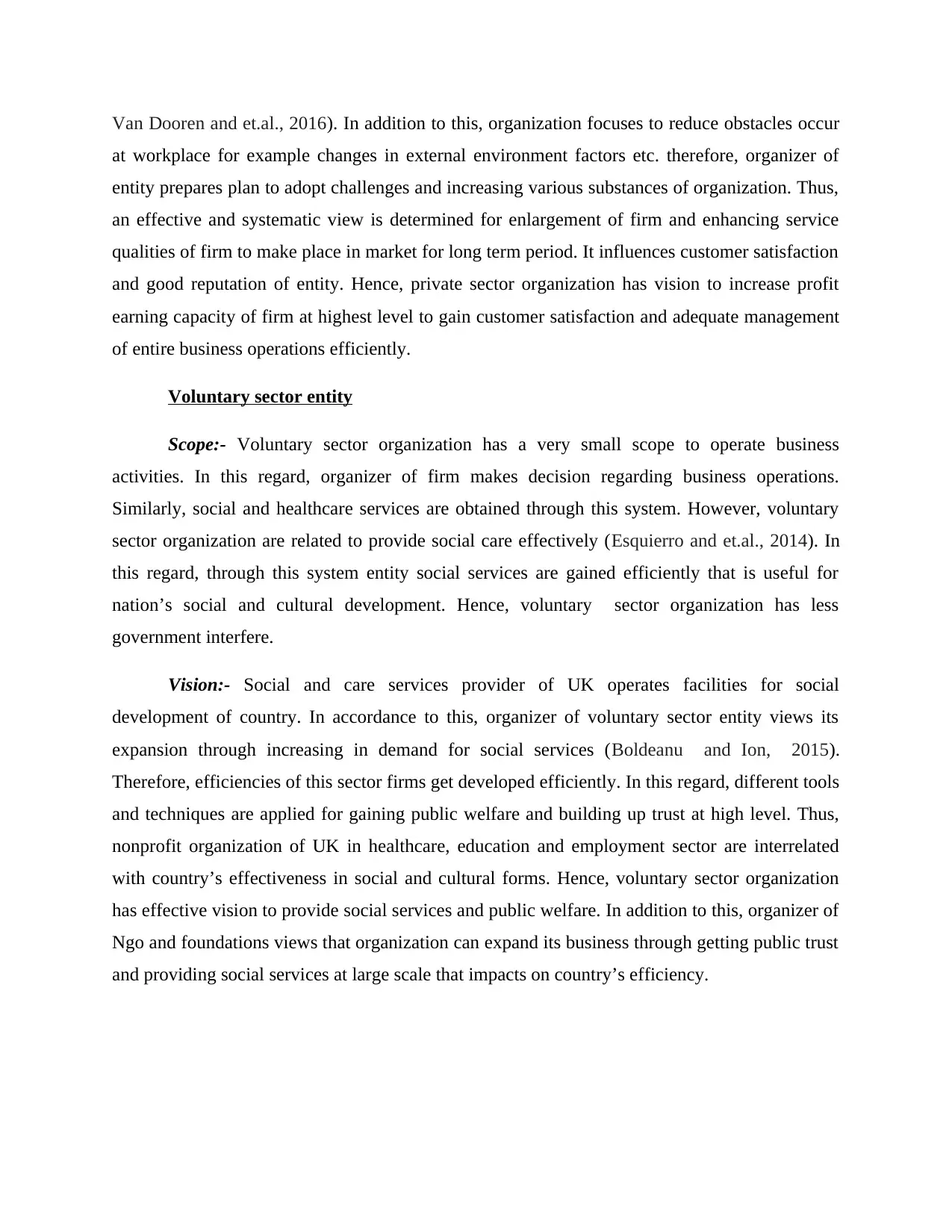
Van Dooren and et.al., 2016). In addition to this, organization focuses to reduce obstacles occur
at workplace for example changes in external environment factors etc. therefore, organizer of
entity prepares plan to adopt challenges and increasing various substances of organization. Thus,
an effective and systematic view is determined for enlargement of firm and enhancing service
qualities of firm to make place in market for long term period. It influences customer satisfaction
and good reputation of entity. Hence, private sector organization has vision to increase profit
earning capacity of firm at highest level to gain customer satisfaction and adequate management
of entire business operations efficiently.
Voluntary sector entity
Scope:- Voluntary sector organization has a very small scope to operate business
activities. In this regard, organizer of firm makes decision regarding business operations.
Similarly, social and healthcare services are obtained through this system. However, voluntary
sector organization are related to provide social care effectively (Esquierro and et.al., 2014). In
this regard, through this system entity social services are gained efficiently that is useful for
nation’s social and cultural development. Hence, voluntary sector organization has less
government interfere.
Vision:- Social and care services provider of UK operates facilities for social
development of country. In accordance to this, organizer of voluntary sector entity views its
expansion through increasing in demand for social services (Boldeanu and Ion, 2015).
Therefore, efficiencies of this sector firms get developed efficiently. In this regard, different tools
and techniques are applied for gaining public welfare and building up trust at high level. Thus,
nonprofit organization of UK in healthcare, education and employment sector are interrelated
with country’s effectiveness in social and cultural forms. Hence, voluntary sector organization
has effective vision to provide social services and public welfare. In addition to this, organizer of
Ngo and foundations views that organization can expand its business through getting public trust
and providing social services at large scale that impacts on country’s efficiency.
at workplace for example changes in external environment factors etc. therefore, organizer of
entity prepares plan to adopt challenges and increasing various substances of organization. Thus,
an effective and systematic view is determined for enlargement of firm and enhancing service
qualities of firm to make place in market for long term period. It influences customer satisfaction
and good reputation of entity. Hence, private sector organization has vision to increase profit
earning capacity of firm at highest level to gain customer satisfaction and adequate management
of entire business operations efficiently.
Voluntary sector entity
Scope:- Voluntary sector organization has a very small scope to operate business
activities. In this regard, organizer of firm makes decision regarding business operations.
Similarly, social and healthcare services are obtained through this system. However, voluntary
sector organization are related to provide social care effectively (Esquierro and et.al., 2014). In
this regard, through this system entity social services are gained efficiently that is useful for
nation’s social and cultural development. Hence, voluntary sector organization has less
government interfere.
Vision:- Social and care services provider of UK operates facilities for social
development of country. In accordance to this, organizer of voluntary sector entity views its
expansion through increasing in demand for social services (Boldeanu and Ion, 2015).
Therefore, efficiencies of this sector firms get developed efficiently. In this regard, different tools
and techniques are applied for gaining public welfare and building up trust at high level. Thus,
nonprofit organization of UK in healthcare, education and employment sector are interrelated
with country’s effectiveness in social and cultural forms. Hence, voluntary sector organization
has effective vision to provide social services and public welfare. In addition to this, organizer of
Ngo and foundations views that organization can expand its business through getting public trust
and providing social services at large scale that impacts on country’s efficiency.
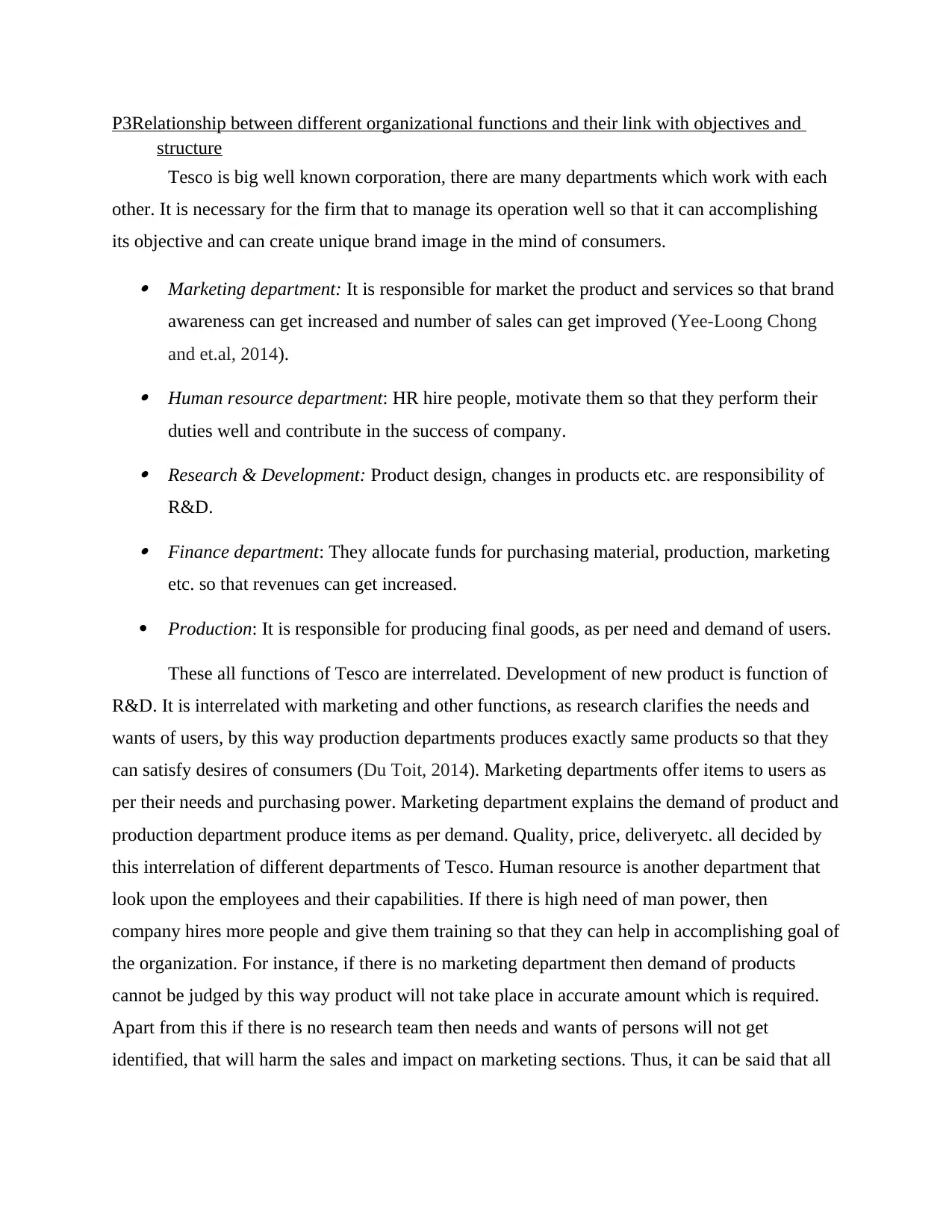
P3Relationship between different organizational functions and their link with objectives and
structure
Tesco is big well known corporation, there are many departments which work with each
other. It is necessary for the firm that to manage its operation well so that it can accomplishing
its objective and can create unique brand image in the mind of consumers.
Marketing department: It is responsible for market the product and services so that brand
awareness can get increased and number of sales can get improved (Yee-Loong Chong
and et.al, 2014). Human resource department: HR hire people, motivate them so that they perform their
duties well and contribute in the success of company. Research & Development: Product design, changes in products etc. are responsibility of
R&D. Finance department: They allocate funds for purchasing material, production, marketing
etc. so that revenues can get increased.
Production: It is responsible for producing final goods, as per need and demand of users.
These all functions of Tesco are interrelated. Development of new product is function of
R&D. It is interrelated with marketing and other functions, as research clarifies the needs and
wants of users, by this way production departments produces exactly same products so that they
can satisfy desires of consumers (Du Toit, 2014). Marketing departments offer items to users as
per their needs and purchasing power. Marketing department explains the demand of product and
production department produce items as per demand. Quality, price, deliveryetc. all decided by
this interrelation of different departments of Tesco. Human resource is another department that
look upon the employees and their capabilities. If there is high need of man power, then
company hires more people and give them training so that they can help in accomplishing goal of
the organization. For instance, if there is no marketing department then demand of products
cannot be judged by this way product will not take place in accurate amount which is required.
Apart from this if there is no research team then needs and wants of persons will not get
identified, that will harm the sales and impact on marketing sections. Thus, it can be said that all
structure
Tesco is big well known corporation, there are many departments which work with each
other. It is necessary for the firm that to manage its operation well so that it can accomplishing
its objective and can create unique brand image in the mind of consumers.
Marketing department: It is responsible for market the product and services so that brand
awareness can get increased and number of sales can get improved (Yee-Loong Chong
and et.al, 2014). Human resource department: HR hire people, motivate them so that they perform their
duties well and contribute in the success of company. Research & Development: Product design, changes in products etc. are responsibility of
R&D. Finance department: They allocate funds for purchasing material, production, marketing
etc. so that revenues can get increased.
Production: It is responsible for producing final goods, as per need and demand of users.
These all functions of Tesco are interrelated. Development of new product is function of
R&D. It is interrelated with marketing and other functions, as research clarifies the needs and
wants of users, by this way production departments produces exactly same products so that they
can satisfy desires of consumers (Du Toit, 2014). Marketing departments offer items to users as
per their needs and purchasing power. Marketing department explains the demand of product and
production department produce items as per demand. Quality, price, deliveryetc. all decided by
this interrelation of different departments of Tesco. Human resource is another department that
look upon the employees and their capabilities. If there is high need of man power, then
company hires more people and give them training so that they can help in accomplishing goal of
the organization. For instance, if there is no marketing department then demand of products
cannot be judged by this way product will not take place in accurate amount which is required.
Apart from this if there is no research team then needs and wants of persons will not get
identified, that will harm the sales and impact on marketing sections. Thus, it can be said that all
⊘ This is a preview!⊘
Do you want full access?
Subscribe today to unlock all pages.

Trusted by 1+ million students worldwide
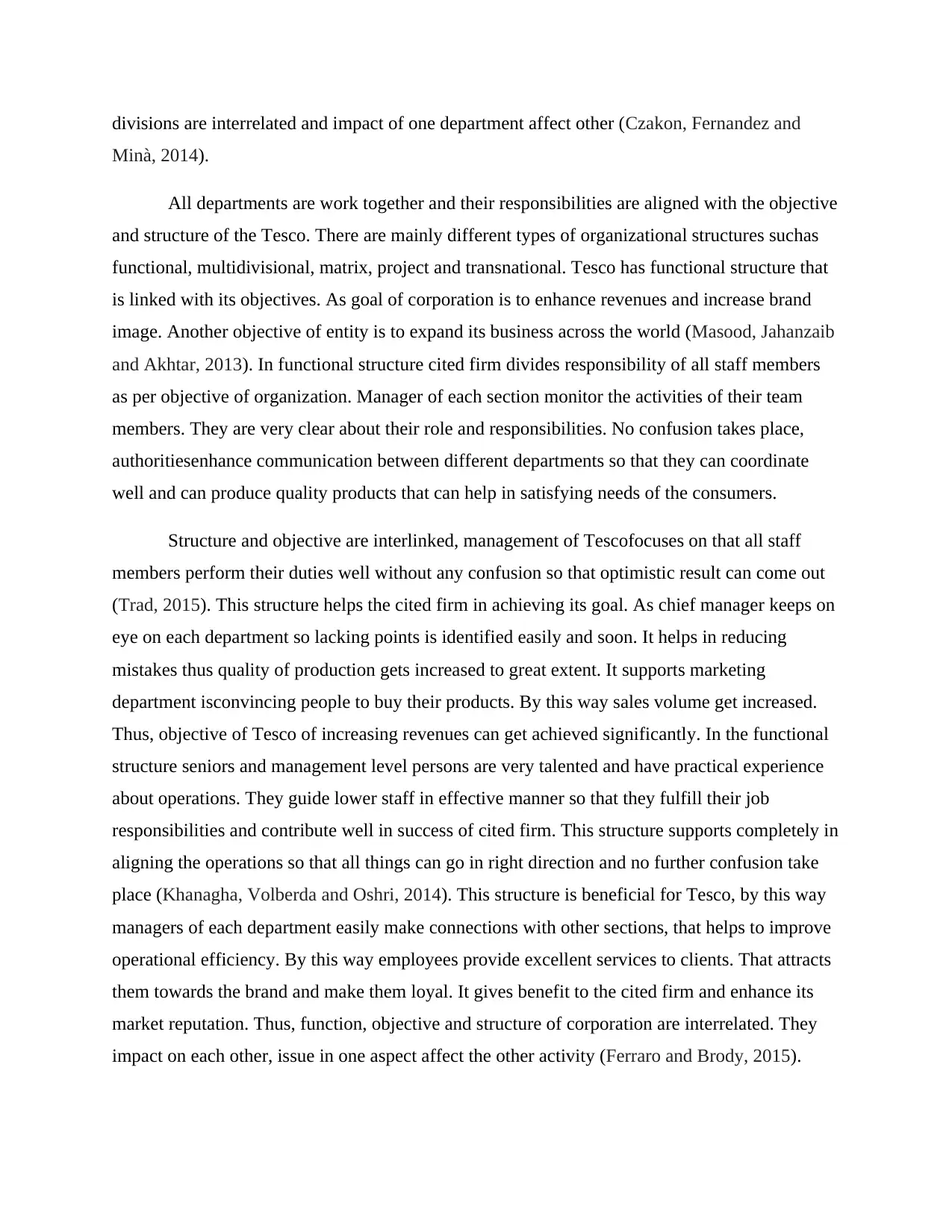
divisions are interrelated and impact of one department affect other (Czakon, Fernandez and
Minà, 2014).
All departments are work together and their responsibilities are aligned with the objective
and structure of the Tesco. There are mainly different types of organizational structures suchas
functional, multidivisional, matrix, project and transnational. Tesco has functional structure that
is linked with its objectives. As goal of corporation is to enhance revenues and increase brand
image. Another objective of entity is to expand its business across the world (Masood, Jahanzaib
and Akhtar, 2013). In functional structure cited firm divides responsibility of all staff members
as per objective of organization. Manager of each section monitor the activities of their team
members. They are very clear about their role and responsibilities. No confusion takes place,
authoritiesenhance communication between different departments so that they can coordinate
well and can produce quality products that can help in satisfying needs of the consumers.
Structure and objective are interlinked, management of Tescofocuses on that all staff
members perform their duties well without any confusion so that optimistic result can come out
(Trad, 2015). This structure helps the cited firm in achieving its goal. As chief manager keeps on
eye on each department so lacking points is identified easily and soon. It helps in reducing
mistakes thus quality of production gets increased to great extent. It supports marketing
department isconvincing people to buy their products. By this way sales volume get increased.
Thus, objective of Tesco of increasing revenues can get achieved significantly. In the functional
structure seniors and management level persons are very talented and have practical experience
about operations. They guide lower staff in effective manner so that they fulfill their job
responsibilities and contribute well in success of cited firm. This structure supports completely in
aligning the operations so that all things can go in right direction and no further confusion take
place (Khanagha, Volberda and Oshri, 2014). This structure is beneficial for Tesco, by this way
managers of each department easily make connections with other sections, that helps to improve
operational efficiency. By this way employees provide excellent services to clients. That attracts
them towards the brand and make them loyal. It gives benefit to the cited firm and enhance its
market reputation. Thus, function, objective and structure of corporation are interrelated. They
impact on each other, issue in one aspect affect the other activity (Ferraro and Brody, 2015).
Minà, 2014).
All departments are work together and their responsibilities are aligned with the objective
and structure of the Tesco. There are mainly different types of organizational structures suchas
functional, multidivisional, matrix, project and transnational. Tesco has functional structure that
is linked with its objectives. As goal of corporation is to enhance revenues and increase brand
image. Another objective of entity is to expand its business across the world (Masood, Jahanzaib
and Akhtar, 2013). In functional structure cited firm divides responsibility of all staff members
as per objective of organization. Manager of each section monitor the activities of their team
members. They are very clear about their role and responsibilities. No confusion takes place,
authoritiesenhance communication between different departments so that they can coordinate
well and can produce quality products that can help in satisfying needs of the consumers.
Structure and objective are interlinked, management of Tescofocuses on that all staff
members perform their duties well without any confusion so that optimistic result can come out
(Trad, 2015). This structure helps the cited firm in achieving its goal. As chief manager keeps on
eye on each department so lacking points is identified easily and soon. It helps in reducing
mistakes thus quality of production gets increased to great extent. It supports marketing
department isconvincing people to buy their products. By this way sales volume get increased.
Thus, objective of Tesco of increasing revenues can get achieved significantly. In the functional
structure seniors and management level persons are very talented and have practical experience
about operations. They guide lower staff in effective manner so that they fulfill their job
responsibilities and contribute well in success of cited firm. This structure supports completely in
aligning the operations so that all things can go in right direction and no further confusion take
place (Khanagha, Volberda and Oshri, 2014). This structure is beneficial for Tesco, by this way
managers of each department easily make connections with other sections, that helps to improve
operational efficiency. By this way employees provide excellent services to clients. That attracts
them towards the brand and make them loyal. It gives benefit to the cited firm and enhance its
market reputation. Thus, function, objective and structure of corporation are interrelated. They
impact on each other, issue in one aspect affect the other activity (Ferraro and Brody, 2015).
Paraphrase This Document
Need a fresh take? Get an instant paraphrase of this document with our AI Paraphraser
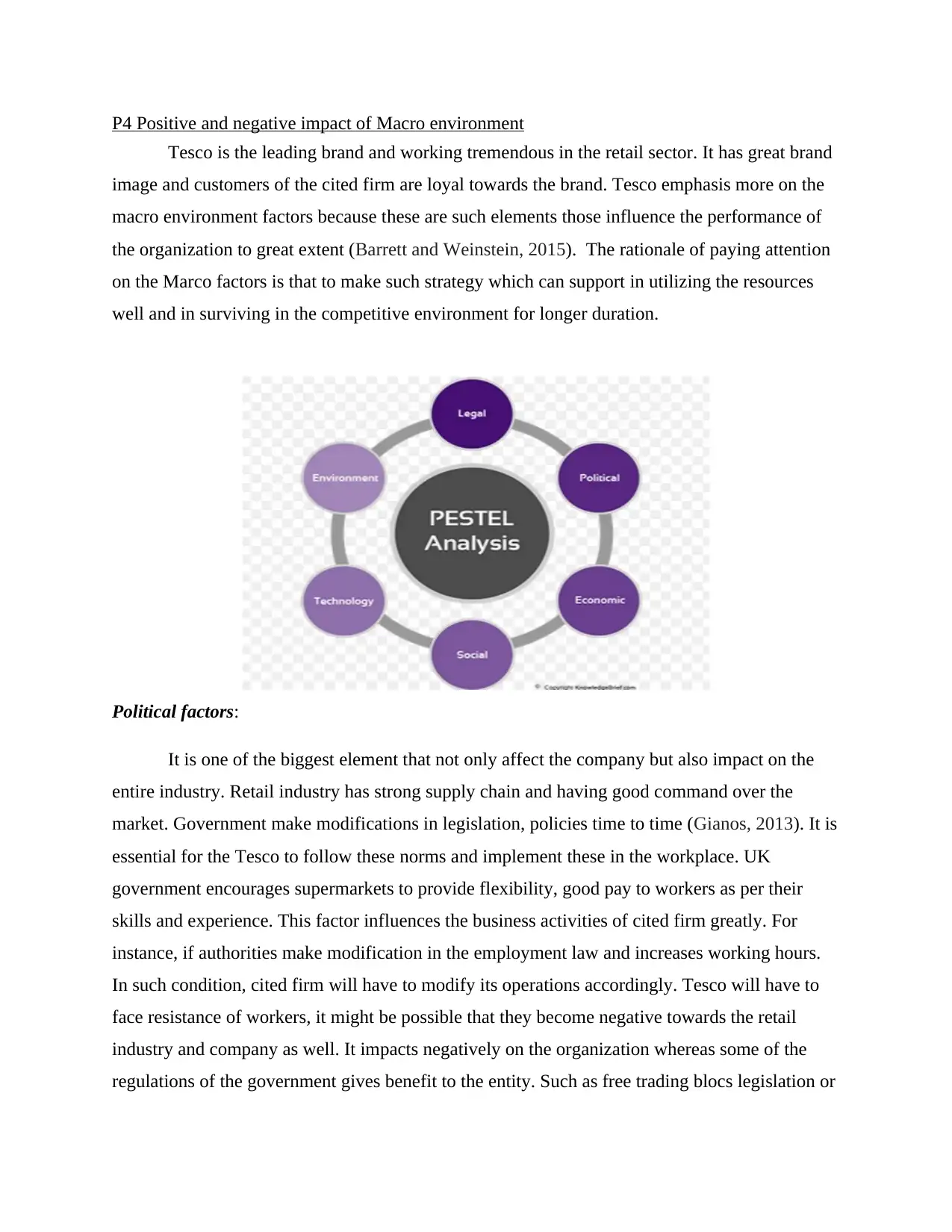
P4 Positive and negative impact of Macro environment
Tesco is the leading brand and working tremendous in the retail sector. It has great brand
image and customers of the cited firm are loyal towards the brand. Tesco emphasis more on the
macro environment factors because these are such elements those influence the performance of
the organization to great extent (Barrett and Weinstein, 2015). The rationale of paying attention
on the Marco factors is that to make such strategy which can support in utilizing the resources
well and in surviving in the competitive environment for longer duration.
Political factors:
It is one of the biggest element that not only affect the company but also impact on the
entire industry. Retail industry has strong supply chain and having good command over the
market. Government make modifications in legislation, policies time to time (Gianos, 2013). It is
essential for the Tesco to follow these norms and implement these in the workplace. UK
government encourages supermarkets to provide flexibility, good pay to workers as per their
skills and experience. This factor influences the business activities of cited firm greatly. For
instance, if authorities make modification in the employment law and increases working hours.
In such condition, cited firm will have to modify its operations accordingly. Tesco will have to
face resistance of workers, it might be possible that they become negative towards the retail
industry and company as well. It impacts negatively on the organization whereas some of the
regulations of the government gives benefit to the entity. Such as free trading blocs legislation or
Tesco is the leading brand and working tremendous in the retail sector. It has great brand
image and customers of the cited firm are loyal towards the brand. Tesco emphasis more on the
macro environment factors because these are such elements those influence the performance of
the organization to great extent (Barrett and Weinstein, 2015). The rationale of paying attention
on the Marco factors is that to make such strategy which can support in utilizing the resources
well and in surviving in the competitive environment for longer duration.
Political factors:
It is one of the biggest element that not only affect the company but also impact on the
entire industry. Retail industry has strong supply chain and having good command over the
market. Government make modifications in legislation, policies time to time (Gianos, 2013). It is
essential for the Tesco to follow these norms and implement these in the workplace. UK
government encourages supermarkets to provide flexibility, good pay to workers as per their
skills and experience. This factor influences the business activities of cited firm greatly. For
instance, if authorities make modification in the employment law and increases working hours.
In such condition, cited firm will have to modify its operations accordingly. Tesco will have to
face resistance of workers, it might be possible that they become negative towards the retail
industry and company as well. It impacts negatively on the organization whereas some of the
regulations of the government gives benefit to the entity. Such as free trading blocs legislation or
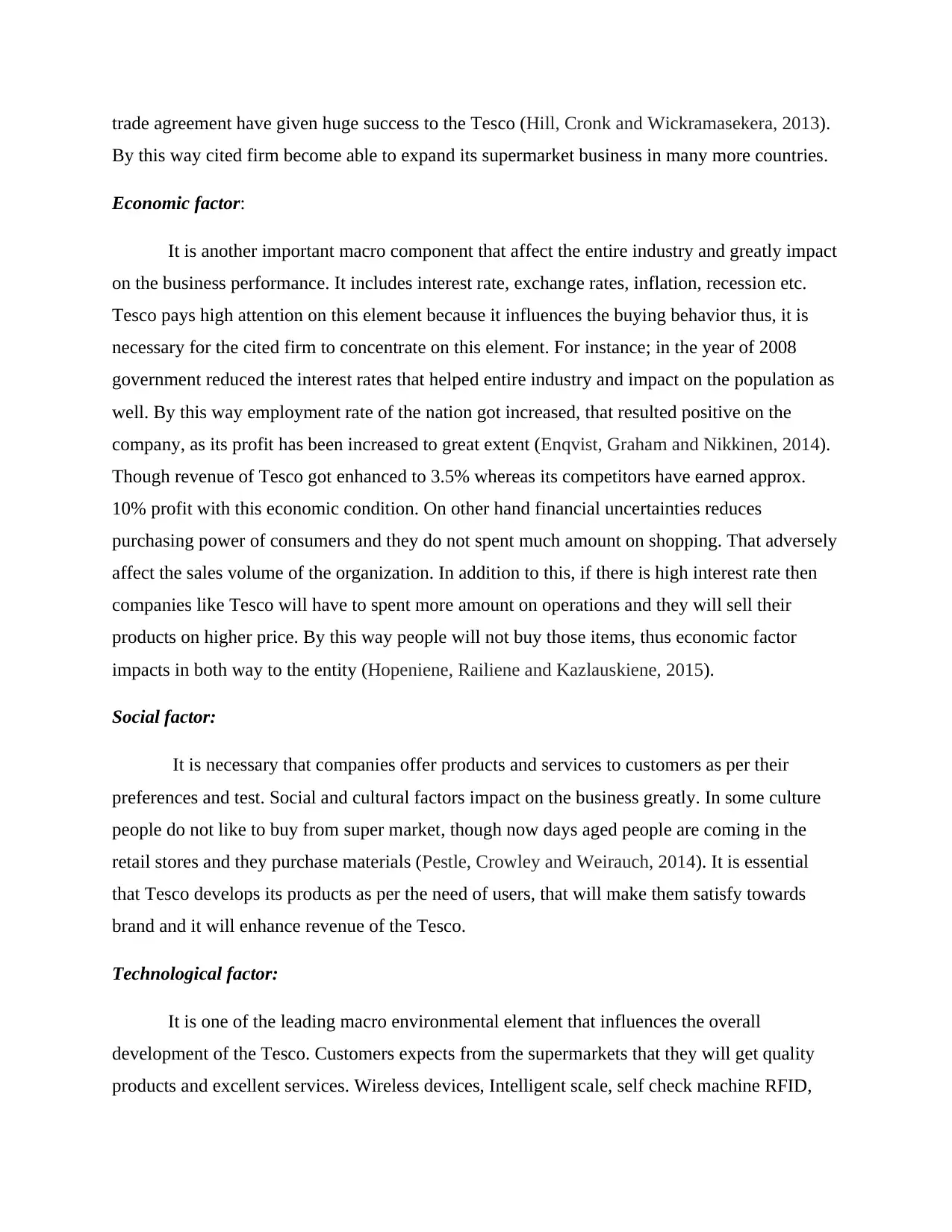
trade agreement have given huge success to the Tesco (Hill, Cronk and Wickramasekera, 2013).
By this way cited firm become able to expand its supermarket business in many more countries.
Economic factor:
It is another important macro component that affect the entire industry and greatly impact
on the business performance. It includes interest rate, exchange rates, inflation, recession etc.
Tesco pays high attention on this element because it influences the buying behavior thus, it is
necessary for the cited firm to concentrate on this element. For instance; in the year of 2008
government reduced the interest rates that helped entire industry and impact on the population as
well. By this way employment rate of the nation got increased, that resulted positive on the
company, as its profit has been increased to great extent (Enqvist, Graham and Nikkinen, 2014).
Though revenue of Tesco got enhanced to 3.5% whereas its competitors have earned approx.
10% profit with this economic condition. On other hand financial uncertainties reduces
purchasing power of consumers and they do not spent much amount on shopping. That adversely
affect the sales volume of the organization. In addition to this, if there is high interest rate then
companies like Tesco will have to spent more amount on operations and they will sell their
products on higher price. By this way people will not buy those items, thus economic factor
impacts in both way to the entity (Hopeniene, Railiene and Kazlauskiene, 2015).
Social factor:
It is necessary that companies offer products and services to customers as per their
preferences and test. Social and cultural factors impact on the business greatly. In some culture
people do not like to buy from super market, though now days aged people are coming in the
retail stores and they purchase materials (Pestle, Crowley and Weirauch, 2014). It is essential
that Tesco develops its products as per the need of users, that will make them satisfy towards
brand and it will enhance revenue of the Tesco.
Technological factor:
It is one of the leading macro environmental element that influences the overall
development of the Tesco. Customers expects from the supermarkets that they will get quality
products and excellent services. Wireless devices, Intelligent scale, self check machine RFID,
By this way cited firm become able to expand its supermarket business in many more countries.
Economic factor:
It is another important macro component that affect the entire industry and greatly impact
on the business performance. It includes interest rate, exchange rates, inflation, recession etc.
Tesco pays high attention on this element because it influences the buying behavior thus, it is
necessary for the cited firm to concentrate on this element. For instance; in the year of 2008
government reduced the interest rates that helped entire industry and impact on the population as
well. By this way employment rate of the nation got increased, that resulted positive on the
company, as its profit has been increased to great extent (Enqvist, Graham and Nikkinen, 2014).
Though revenue of Tesco got enhanced to 3.5% whereas its competitors have earned approx.
10% profit with this economic condition. On other hand financial uncertainties reduces
purchasing power of consumers and they do not spent much amount on shopping. That adversely
affect the sales volume of the organization. In addition to this, if there is high interest rate then
companies like Tesco will have to spent more amount on operations and they will sell their
products on higher price. By this way people will not buy those items, thus economic factor
impacts in both way to the entity (Hopeniene, Railiene and Kazlauskiene, 2015).
Social factor:
It is necessary that companies offer products and services to customers as per their
preferences and test. Social and cultural factors impact on the business greatly. In some culture
people do not like to buy from super market, though now days aged people are coming in the
retail stores and they purchase materials (Pestle, Crowley and Weirauch, 2014). It is essential
that Tesco develops its products as per the need of users, that will make them satisfy towards
brand and it will enhance revenue of the Tesco.
Technological factor:
It is one of the leading macro environmental element that influences the overall
development of the Tesco. Customers expects from the supermarkets that they will get quality
products and excellent services. Wireless devices, Intelligent scale, self check machine RFID,
⊘ This is a preview!⊘
Do you want full access?
Subscribe today to unlock all pages.

Trusted by 1+ million students worldwide
1 out of 25
Related Documents
Your All-in-One AI-Powered Toolkit for Academic Success.
+13062052269
info@desklib.com
Available 24*7 on WhatsApp / Email
![[object Object]](/_next/static/media/star-bottom.7253800d.svg)
Unlock your academic potential
Copyright © 2020–2025 A2Z Services. All Rights Reserved. Developed and managed by ZUCOL.





